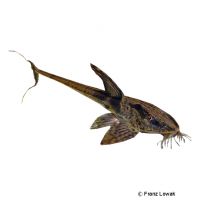Crying Whiptail (Loricaria sp. 'Rio Atabapo')
| Crying Whiptail Loricaria sp. 'Rio Atabapo' | |
|---|---|
| Name | Crying Whiptail |
| Name Lat. | Loricaria sp. 'Rio Atabapo' |
| Family | Suckermouth Armoured Catfishes |
| Family lat. | Loricariidae |
| Order | Catfishes |
| Order lat. | Siluriformes |
| Origin | Colombia |
| Habitat | Rivers, streams |
| Diet | Omnivore |
| pH | 6.5-7.5 |
| Behavior | Nocturnal, peaceful |
| Keeping | Pair, group |
| Care Level | Moderate |
| Reproduction | Mouthbrooder |
| Breeding | Moderately difficult |
| Life Span | 5-8 years |
| Protection | No |
| Metric Units | |
| Size | 20 cm |
| Temperature | 24-28 °C |
| Hardness | 1-15 °dH |
| Aquarium | ~ 250 l |
| US Units | |
| Size | 8" |
| Temperature | 75-82 °F |
| Hardness | 18-267 ppm |
| Aquarium | ~ 65 gal |
Distribution and habitat
The crepuscular to nocturnal bridled witch catfish are common in the flowing waters of the upper Rio Meta drainage in Colombia. They live in shallow water preferentially on sandy bottoms among fallen leaves, sunken logs, branches and roots protruding into the water.
Maintenance
The aquarium should have a dense border planting, with many hiding places (stones, roots, caves) and free sandy areas, as well as plenty of swimming space. A deep sandy substrate covered with some foliage (e.g. seaside mallow, oak), subdued light and slightly acidic water with a medium current is ideal.
No ammonia, ammonium and nitrite should be detectable, nitrate value should not exceed 100 mg/l. To ensure water quality and oxygen content, a filter and heater adapted to the aquarium size is required, as well as lighting for the species-appropriate day-night rhythm of the animals.
Diet
They feed on animal food. The food supply consists of live, frozen and dry food. For a balanced diet, feed once a day with a high-quality, protein-rich dry food for loricariids (granules, pellets, chips, tablets) as well as zooplankton, cyclops, daphnia, artemia, mosquito larvae, shrimp, etc. (live or frozen).
Only feed as much as will be eaten within a few minutes. Regular and varied feeding promotes health and increases resistance.
Behaviour and compatibility
They are swimming, peaceful catfish, which behave somewhat territorial only during the spawning season. It is recommended to keep them in pairs or better in a group of 3-5. They can be well socialized with other calm and peaceful fish, such as small tetras, peaceful cichlids and armored catfish
Basically, only compatible fish species with similar demands on water condition and water temperature should be socialized.
Sex dimorphism
The sexes are difficult to distinguish. Sexually mature males have a distinctly enlarged mouth and spawning females appear rounder
Reproduction and breeding
They are paternal mouth brooders. The male picks up the egg ball in a "lip pocket" for mouth brooding. The egg ball is aerated by moving the mouthparts. After 10-15 days, the larvae hatch and brood care is complete. After another 2-3 days, the fry, about 10 mm in size, have consumed their yolk sac and begin to feed on their own. The fry must be fed several times a day with special rearing food (Artemia nauplii, microworms, Cylops, fine dry food)
In community tanks breeding is hardly possible, because the fry are easy prey.
Important
The bridled witch catfishes like to burrow into the sandy soils. In the large distribution area there are some differently colored variants.
The foliage (sea almond tree, oak, etc.) enriches the water with humic substances and naturally lowers the pH
When catching, use as fine-meshed nets as possible so that the hard rays of the pectoral fins or the skin teeth (odontodes) do not get caught on the bone plates, which can cause painful puncture wounds when touched.
The well-being of the fish should be checked regularly. Temperature should be checked daily, pH, hardness and nitrate levels at least every 14 days. Regular partial water changes are recommended, even when contaminant levels have not yet reached the upper limit. Sudden changes in water quality should be avoided. Newly introduced fish must be accustomed slowly to the water in the aquarium.
Further literature can be found in your pet store.
References
Text: Werner Winter; Image: Franz Lowak
Source: BMELV (1998): Tierschutzgutachten - Haltung von Zierfischen (Süßwasser); ENGELMANN (2005): Zootierhaltung - Tiere in menschlicher Obhut: Fische, Verlag Harri Deutsch
- Gemäß § 21 Abs. 5 Tierschutzgesetz idgF
